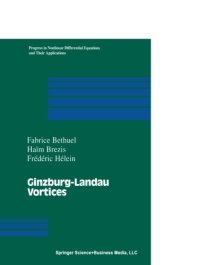
Ebook: Ginzburg-Landau Vortices
- Tags: Wirbelströmung, Nichtlineare Differentialgleichung, Singularität -- (Math.), Suprafluidität -- Mathematische Methode, Supraleitung -- Mathematische Methode, Ginzburg-Landau-Gleichung, Differential -- Numerical solutions, Mathematical physics, Singularities (Mathematics), Superconductors -- Mathematics, Superfluidity -- Mathematics, Ginzburg-Landau-Gleichung
- Series: Progress in nonlinear differential equations and their applications 13
- Year: 1994
- Publisher: Birkhäuser
- City: Boston u.a
- Language: English
- djvu
The original motivation of this study comes from the following questions that were mentioned to one ofus by H. Matano. Let 2 2 G= B = {x=(X1lX2) E 2 ; x~ + x~ = Ixl < 1}. 1 Consider the Ginzburg-Landau functional 2 2 (1) E~(u) = ~ LIVul + 4~2 L(lu1 _1)2 which is defined for maps u E H1(G;C) also identified with Hl(G;R2). Fix the boundary condition 9(X) =X on 8G and set H; = {u E H1(G;C); u = 9 on 8G}. It is easy to see that (2) is achieved by some u~ that is smooth and satisfies the Euler equation in G, -~u~ = :2 u~(1 _lu~12) (3) { on aGo u~ =9 Themaximum principleeasily implies (see e.g., F. Bethuel, H. Brezisand F. Helein (2]) that any solution u~ of (3) satisfies lu~1 ~ 1 in G. In particular, a subsequence (u~,.) converges in the w* - LOO(G) topology to a limit u*
Download the book Ginzburg-Landau Vortices for free or read online
Continue reading on any device:

Last viewed books
Related books
{related-news}
Comments (0)